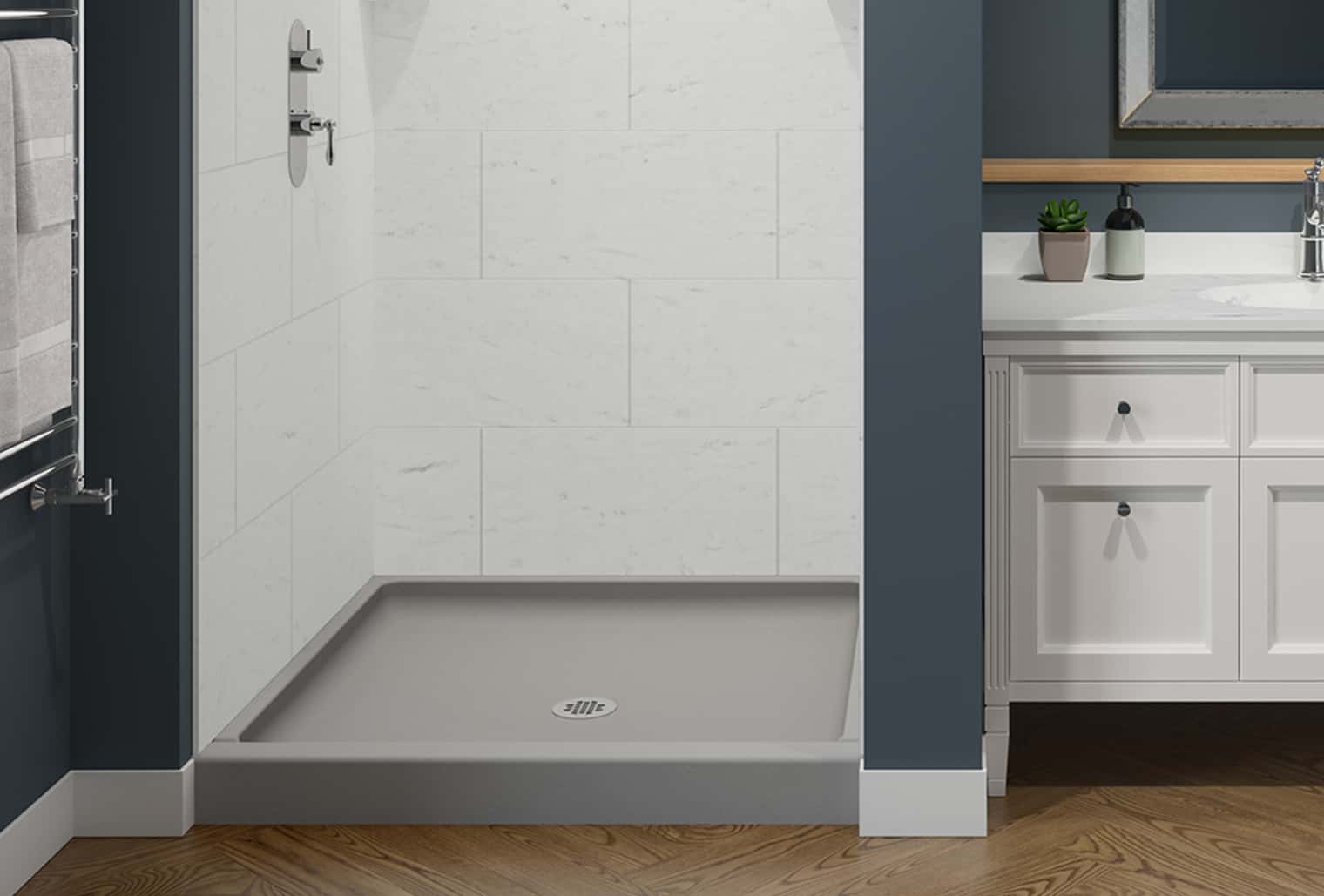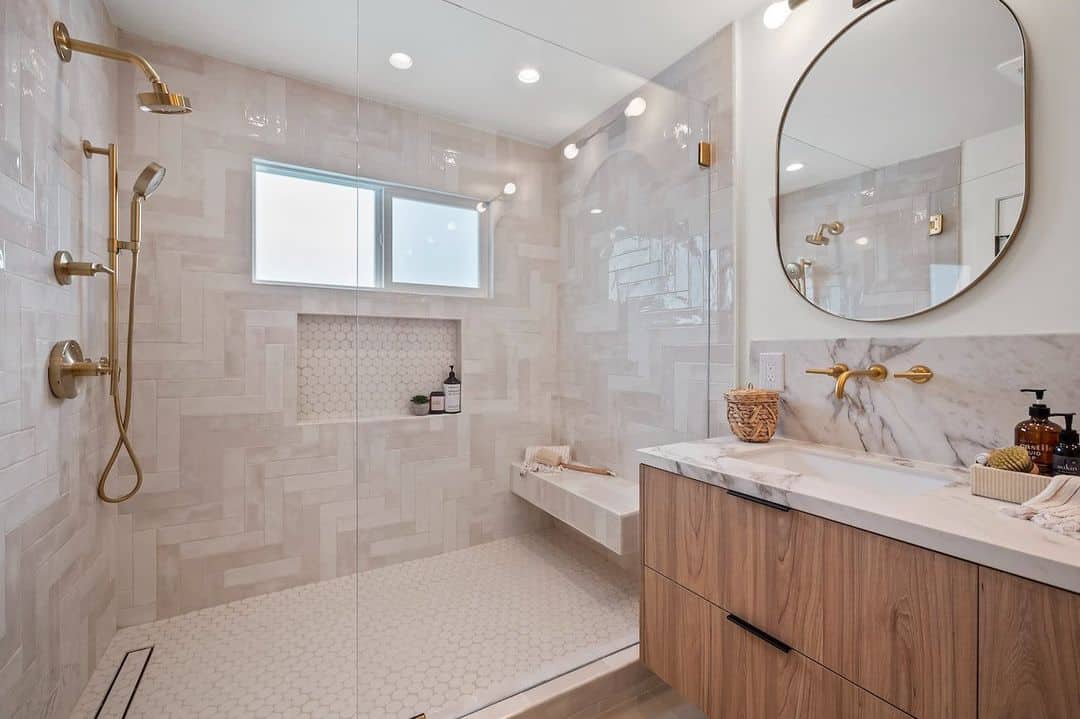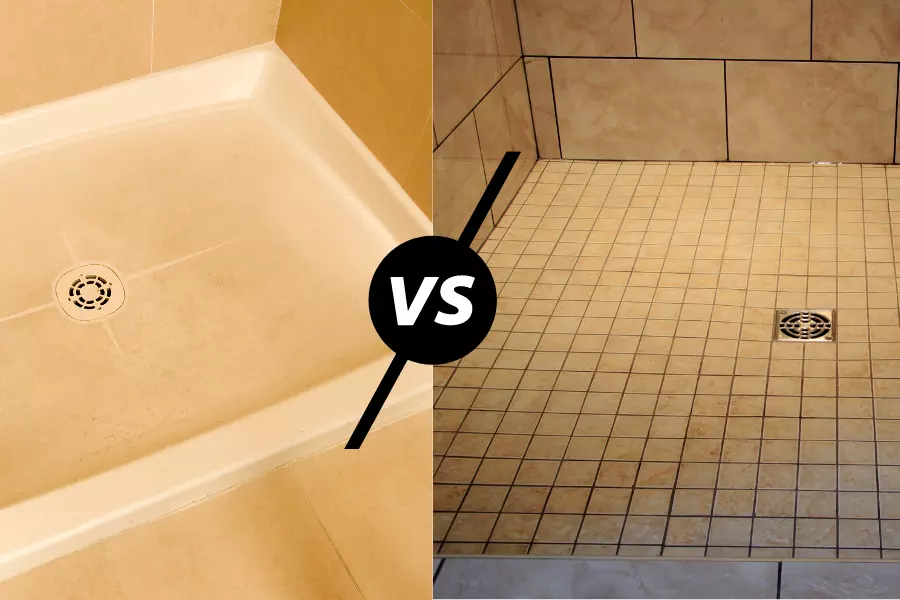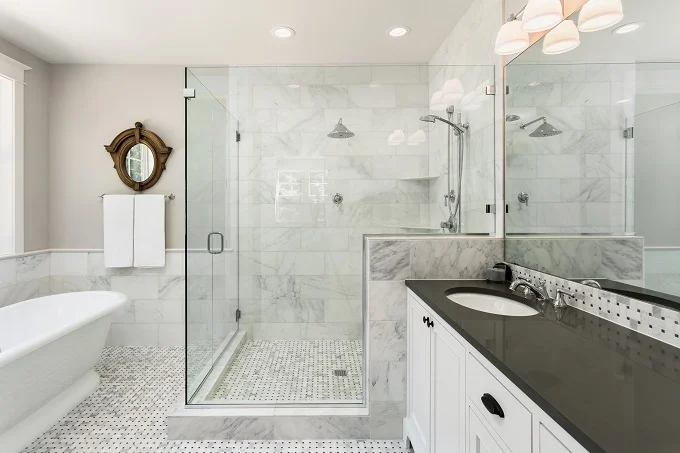Whether you’re remodeling your bathroom or installing a shower for the first time, you need to take time to weigh the pros and cons of different flooring options. Most homeowners find themselves comparing shower pans and tile floors in this area.
Many opt for a shower pan because it’s cheaper to purchase and install and easier to maintain. Those who choose tile shower floors pay extra for the aesthetic appeal and have more customization options.
While these two shower bases may seem like exact replacements for each other, there is a lot to consider before making your final decision.
Shower Pan or Tile Floor?
Before we dive into the differences between shower pans and tile floors, we can cover some of the similarities.
Both shower base options will get the job done if installed correctly, and they both benefit from the addition of a shower curb to keep water in the stall.
The decision mostly comes down to your budget, the workload, and the desired appearance of your finished shower.
Shower Pan

Most shower pans are prefabricated to meet a certain standard size. While a large single piece may be more difficult to transport safely (they are often damaged in transport), installation on a level subfloor is as simple as screwing the pan down and putting up the shower walls around it.
There are several types of shower pans, including popular options such as:
- Fiberglass shower pans: affordable, lightweight, and easy to install; discolor easily
- Acrylic shower pans: affordable and lightweight with more color options; not as durable
- Molded shower pans: made of synthetic plastic and natural stone for more stylish appearance; durable, easy to clean, and mold and mildew resistant
- Cast-iron shower pans: heaviest and most durable; different finishes and styles; retains heat well, but cold in winter
- Cultured marble shower pans: cut from a single stone for the shower; very costly and attractive; needs proper sealing and cleaning to prevent product absorption
The type of shower pan you choose greatly affects the appearance and cost of your build, especially if you end up paying for a custom size or shape.
Tile Floor

Shower tiles are often ceramic or porcelain, and you must install a specific base with a waterproof liner before you can set your tiles. In some cases, you can use a shower pan designed to host tiles, but in most builds, you’re creating the pan with your tile, grout, and seal.
Tile floor in a shower requires more work to install, and homeowners will spend more time keeping up with the tile over its lifetime. If there’s ever an issue with the shower floor, renovations or repairs usually involve ripping up the tile, leading to more work and costs.
Overall, tile floor is preferred for its visual appeal. While grout lines may be a pain for some to clean, tile has a more high-end look than a solid shower base, and it can increase the resale value of the home.
Shower Pans and Tile Floors Compared
While shower pans and tile floors accomplish the same task, they differ in areas such as:
- Cost of materials and installation
- Ease of installation
- Upkeep and maintenance
- Durability
- Waterproofing considering
- Adaptability to non-standard showers
- Eco-friendliness
These are all things that you should consider before making the final decision in your bathroom remodel or new shower.

Cost
If you’re making your decision on cost alone, a shower pan is the better option.
The prefabrication process for making shower pans allows manufacturers to make them in bulk and sell them for a lower per unit cost. Their simple design has a simple installation process, and you don’t need to spend extra money on other materials.
Shower tiles cost more to start, especially with the need to purchase tiles rated for watery environments, and the price only goes up from there.
In addition to the original tiles, you must purchase supplies and tools for grout. The installation process takes more time and skill, and if you go the professional route it may multiply your costs.
Installation
Shower pans are also much easier to install, and it’s something you may be able to do yourself. There is less prep work involved, and in most cases, you simply insert the pan, screw it down, and seal the area.
Installation of a shower pan takes less than a day while laying shower tiles can take as long as a week. They require more work to make sure the tiles are level and properly spaced, to ensure proper slope and drain, and to grout, seal, and cure.
As you would expect, easy installation is a major selling point of shower pans, and it relates to lower maintenance requirements and lower costs overall.
Maintenance
Unless you have a cultured marble shower pan, you don’t need to worry about special cleaning methods after installation. For most, cleaning is as simple as wiping the pan down with a general purpose cleaner.
Most shower tiles require a specialized cleaner to prevent damage to the material, and you will spend more time keeping the grout lines clean. Eventually, shower tiles must be regrouted and resealed to maintain their waterproofing.
If your shower pan breaks, removal and replacement are much more straightforward. If you have an issue with your shower tile floor, you will spend more time and money on breaking up the tiles.
Durability
The durability of your shower floor differs depending on the material you choose. Materials like fiberglass and acrylic used to keep shower pan costs low break easily, although most of these issues occur in transit.
If they’re well maintained, cast iron pans, marble slabs, and tile flooring are the most durable option. While cheaper pans may last about 10 years without issue, these higher quality materials can last 20 years or longer when you take care of them.
Proper installation can make or break your shower flooring, and it pays off to have a professional install if you’re unsure of your own skills. Failing to keep up with routine maintenance, such as regrouting, can also prematurely compromise your shower floor.
Waterproofing

When installed correctly, you shouldn’t have any issue with water leaking through your shower pan or shower tiles to compromise your subfloor. Here, the bigger issue is what could go wrong.
Shower tiles have a greater chance of allowing water to escape into your subfloor. If you don’t stay on top of regrouting and sealing your tiles (or your grout shrinks) then water will slip through the cracks without you noticing.
The recommendation for sealing grout seems to change depending on who you ask. In general, we recommend sealing grout every six months in high traffic areas.
You may be able to drop this down to every year or two in a low-traffic area, such as a guest bathroom where the shower is rarely touched.
Weight
With the exception of cast-iron and slabs, shower pans are usually the lighter option. This makes them the better option for floors where weight may be an issue.
Shower tiles require a thick and heavy subfloor to support their weight. Installing them without proper support will damage your floor over time. This only gets worse as the tiles shift, the grout cracks, and water seeps through to the compromised floor.
Adaptability (Custom Jobs)
If you have an oddly shaped or sized shower, you may run into issues finding a shower pan to fit. Standardization does wonders for keeping costs low, but it also forces you to jump through hoops anytime things are out of standard.
You can get customized shower pans (for an additional fee), but expect this to add to your cost and timeline. Those with showers significantly larger than the standard size will have a much harder time.
Tiles are great for those who want more artistic freedom in the design of their shower, and they may be cheaper than a custom shower pan in some cases.
Eco-Friendliness
Tiles are often considered more eco-friendly. They have a greater variety of uses, meaning they aren’t saddled with one task, and are often made of biodegradable materials.
Shower tiles can be repurposed in other areas of the home or even in art pieces if they’re broken down.
Most shower pans use synthetic materials, such as PVC or fiberglass, and will not degrade over time. The only bonus here is that they can be removed and relocated to serve the same purpose, whereas shower tiles are difficult to remove with enough integrity for reuse in the shower.
In Conclusion
The decision between a pan or tile floor for your shower makes a huge difference on the budget and appearance of your bathroom, and it’s something you should figure out early on in your project.
When choosing between the two, remember the work within your budget and weigh the pros and cons of aesthetics and maintenance. Make sure the flooring you choose compliments your home perfectly before diving in.
Feel free to reach out in the comments if you’re still unsure which option would work better for you.